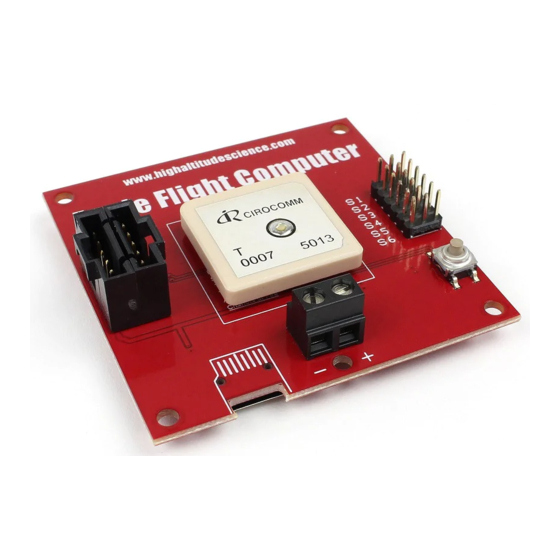High Altitude Science Eagle Flight Computer Manuel - Sayfa 2
Anakart High Altitude Science Eagle Flight Computer için çevrimiçi göz atın veya pdf Manuel indirin. High Altitude Science Eagle Flight Computer 6 sayfaları.

Congratulations! You are the proud owner of what is currently the most powerful and robust flight computer
designed to operate at the very edge of space! This flight computer was designed using lessons learned from
working with computers onboard the International Space Station. It was also designed to meet military
specifications. That means your flight computer will reliably operate at temperatures as cold as – 55 C or - 67 F.
To get the most out of your new flight computer, please take the time to become familiar with its features by
reading though this manual.
We test every flight computer before shipping it out. However, we still ask that you test your flight computer a
few days before every launch. If it doesn't perform as expected, we will replace any flight computer with
manufacturing defects within a year of purchase.
GPS Receiver – Unlike most GPS receivers that cut out at 18,000 m ~ 60,000 ft due to military regulations, the
GPS receiver on your Eagle Flight Computer will continue to operate at altitudes of over 80,000 m ~ 260,000 ft.
Sensor Ports – There are multiple Sensor Ports that allow you to connect an assortment of sensor modules
developed by High Altitude Science to your flight computer. To make things easier, we use keyed connectors
so you don't have to worry about connecting your sensor module backwards and destroying it. Once a sensor
module is connected, the computer will automatically detect it when you power it on.
Servo Header – On older versions, the servo header is used for transmitting APRS data via the
Radio
Bug. Since
the Radio Bug is now obsolete (The
StratoTrack
is more affordable and has greater capability), the servo
header has been dropped from the design as it was easy to damage.
Micro SD – All data from the flight computer is saved to a comma delimited .txt file on a micro SD card
allowing you to easily read your data and export it into a Microsoft Excel file for analysis.
IMPORTANT:
the
micro SD card must be 8 GB or smaller.
System LED – Think of it as your computer's heartbeat. Even though it's just one LED, it will give you a lot of
information once you know how to read it. It's a super bright LED allowing you to easily confirm the correct
operation of your flight computer, even in direct sunlight.
Power Terminal – Allows you to connect your computer to any power source from 4.5 to 6.0 VDC. This means
you can power your computer with as little as 3 AA's allowing you to save both weight and cost. A stress
release hole is also added at the base of the Power Terminal.
Why No Power Switch? – A power switch is a mechanical device with moving parts which makes it very
intolerant to large changes in temperature. By eliminating the power switch we removed a very common
failure point (especially at high altitudes) and made the flight computer significantly more reliable. If you know
how to solder, you are welcome to add your own power switch between the battery pack and flight computer.
Just make sure it is designed to operate at temperatures as cold as negative 60 C.
www.highaltitudescience.com
Eagle Flight Computer Manual V1.0 – Page 2
